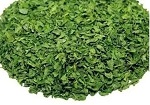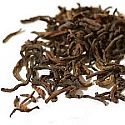Premium Ripe Tuocha Puerh with Chrysanthemum
- Price:
- $46.99 (excluding tax)
- SKU:
- PMTC107
Product Description
Description:
These mini tuos (bird's nest shape buttons) are made from premium grade tea leaves and buttery, spicy chrysanthemum flowers. Enjoy the health benefits and delicious flavor. 5-6 grams each. (please note wrapper may vary from photo) *
What is
Pu-erh Tea?
Welcome to the magical and mysterious world of puerh - a post -fermented
"tea of happiness" that is meticulously crafted and aged,
characterized by its unique flavor. Puerh is often found in pressed brick,
birds nest (tuo) or disc form (bing) - traditional shapes that herald back
hundreds of years to the times of the Tea Horse Road, when tea porters would
carry their weight in tea by foot across mountain passes, trading tea for
Tibetan ponies.
Good quality Puerh tea is made from the large leaf tea variety of Camellia
sinensis var. Assamica that grow in wild tea tree arbors in the high
mountains of China’s Yunnan Province, far away from any industry and pollution.
The oldest living tea tree is believed to be over 3,000 years old and living in
Lincang county. The tribal people of the area revere it as a living ancestor.
Puerh tea made from wild old arbor tea trees are reputed to be more potent,
containing strong Qi (translated as "life energy" or "life
force") that boosts the blood flow and helps the body's circulation.
There are two main types of puerh tea – raw (sheng or “green”), and ripe (shou
or “cooked” ). Properly crafted and aged puerh can be as varied and
complex as fine vintage wines, replete with ‘terroir’ and nuance. Many pu-erh
aficionados find supreme enjoyment in the exploration, contemplation of this
tasty brew.
Raw puerh tea is prepared from tea leaves that are briefly wilted then sundried
into ‘maocha’ before being pressed into cakes or bricks. Over time, natural
microbial activity changes its chemical constitution and it can take up to 5-15
years – some say 20 years – before the tea fully integrates. In Yunnan, sheng
pu is often drunk young, even the current year's vintage! Flavors may include
bitter, astringent, grassy, floral, fruit, camphor, honey, straw, smokey and
most often, layered and delightfully complex. Raw pu-erh is stimulating, full
of "chaqi" (life force energy), elevating to the spirit and best
drink after a meal. New processing techniques are creating sheng puerh’s that
do not need extensive aging and are ready to drink within a couple years time.
In Chinese Medicine, raw pu-erh is considered “cooling” to the system.
Ripe puerh is prepared with the same leaves as a raw puerh but instead is piled
high, undergoing a fermentation process that could last up to 60 days before
the leaves are packed into cakes or bricks. Ripe puerh is usually characterized
by pronounced earthy notes of mushrooms, dirt, wood, tobacco or moss. Dark
chocolate, leather, tar, honey, camphor, cream, rose or sweet jujube date
flavors and aromas are also common in shou puerh. It is usually much darker in
color and less caffeinated than Raw Puerh. If sheng pu is "yang", shu
pu is "yin" and often enjoyed for it's grounding, calming and
centering effects. Ripe puerh is said to be warming to the stomach and spleen
channels in Chinese Medicine thereby aiding in digestion.
PREPARING PU-ERH TEA:
Puerh can be prepared in a few different ways. In Yunnan Province, it is common
practice to boil the leaves and strain before drinking. It is very popular
nowadays, however, to prepare pu-erh in the traditional Gongfu style of
Guangdong, China (see our Brewing below), using small, porous Yixing clay pots
and pouring multiple infusions. Puerh can also be enjoyed European style with
5-7 grams of tea in a pot covered with boiling water, left to steep for 5-10
minutes.
Some things to consider when preparing pu-erh:
*5-7 Grams of tea, or about the size of a quarter makes about 3-4 cups of
puerh, depending on desired strength
*Use purified spring water only, whenever possible
*Generally, cover the tea with boiling water for the best infusion -
starting with steeping for 15 seconds, and up to 10 minutes in later infusions,
depending on vessel and to taste.
* Jasmine blossoms, organic rose buds, chrysanthemum, lavender herbs are nice
additions to puerh in small amounts.
*Purple Bud and “Lao Tou Cha” (tea nugget puerh) are more concentrated than
other puerh; try using less.
One could spend a lifetime learning the art of making tea.
Tea sage, Yu Lu, wrote a book about the intricacies of making a perfect cup
called the Cha Ching or the Classic of Tea, and dedicated 24 implements for the
making of tea. Yet tea embodies the spirit of simplicity; all that is needed to
make a beautiful cup is premium quality tea leaves, a peaceful mind and pure
spring water heated to proper temperature.
Teaware is not only a matter of aesthetics, but is considered an important
element in tea preparation. In the Gongfu style of tea preparation, a clay or
porcelain tea pot or gaiwan is used for the ultimate contemplation of the many
layers and nuance premium teas are known for.
BREWING GUIDE:
WHITE TEA 1-2 T per cup water at 175F steep 3-4
minutes
GREEN TEA 1 T per cup water at 180F
steep 3-4 minutes
JAPANESE GREEN TEA 1T per cup water
160-180F steep 2-3 minutes
ROLLED OOLONG 1t per cup water
190-200F steep 2-4 minutes
LOOSE OOLONG 1T per cup water
190-200F steep 2-4 minutes
BLACK OR 'HONG' TEA 2t per cup water
Boiling steep 3-5 minutes
PUERH TEA 2t per cup water
Boiling steep 3-6 minutes
HERBAL TEA 1T per cup water
Boiling steep 4-5 minutes
Water - Spring or well water is best. avoid tap and distilled water
if possible
Our instructions are only general guidelines - please experiment with steeping
times, water
temperature and amount of leaves for your ultimate enjoyment.
To decrease caffeine levels, flash rinse the tea by pouring hot water over the
leaves,
let sit for 3-5 seconds, then pour the tea water off. This serves to clean and
loosen the tea as well.
Wait 30 seconds to a minute and take a moment to enjoy the aroma before
proceeding
BREWING TEA GONGFU STYLE:
Weigh 5-7 grams of tea - about a quarter size - for a small pot or gaiwan.
Bring water to appropriate temperature.
Flash rinse tea (see above). Wait one minute for leaves to open up; enjoy
aroma.
Pour boiling water over tea leaves and let steep for 7-10 seconds; strain and
serve.
For successive brews, increase steeping times according to taste, adding time
gradually.
White, green and oolong teas can be brewed up to 5-8 times; puerh 8-20 times.
Ingredients:
100% Mini Ripe Tuocha (birds nest) Puerh with Chrysanthemum
Size:
1 lb, 5-6 gram Tuocha (birds nest)
Information and statements about the products on this site have not been evaluated by the Food and Drug Administration and are not intended to diagnose, treat, cure, or prevent any disease. You should not use the information contained herein for diagnosing or treating a health problem or disease, or for prescribing any medication. If you have or suspect a medical problem, promptly contact your health care provider.












